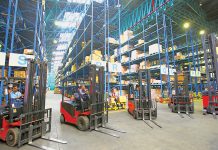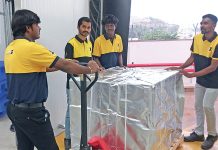To eradicate perishables and agricultural wastage, Indian cold chain companies and logistics service providers need to build resilient perishable supply chains without compromising on quality of products and its cost-competitiveness and invest in improving infrastructure, reefer trucks and advanced technologies.
Ritika Arora Bhola.
Perishable is the only commodity which has not seen a slightest downfall even when the pandemic was at its peak. In fact, the demand for fruits, vegetables, milk, and meat products increased greatly, as consumers preferred healthy eating options more than ever in the past few years. To meet the increased demand, the stakeholders worked diligently on rebuilding highly efficient, and resilient perishable supply chain without compromising on the quality of products and its cost-competitiveness. Huge amount of perishables get wasted in India every year due to pitiable lack of cold storage facilities, smaller number of temperature-controlled reefer trucks to ferry perishables from one destination to another or minimal reach (lots of perishables lie at remote locations and do not get picked up in time) could be the reasons.
According to reports, India produces more than 400 million MT of perishables every year. But the wastage levels of perishables in India are significantly high—4.6-15.9 per cent of fruits, 5.2 per cent of inland fish, 10.5 per cent of marine fish, 2.7 per cent of meat, and 6.7 per cent of poultry. To eliminate the wastage levels and bring back agility, the Indian logistics/cold chain companies need to become flexible, responsive, and cost-effective. At present, modern supply chains are experiencing unprecedented stress and disruptions due to the ongoing crises such as global economic recession, Russia-Ukraine conflict, and lockdowns in China, and are drawing an increased level of scrutiny. Therefore, it is high time the industry introduces innovative, tech-friendly, and unconventional ways of working to uphold perishables movement in India that contributes to the GDP.
“India is a diverse geography, and we have a fragmented market of agri producers which makes it difficult to consolidate. Logistics becomes even more challenging when it comes to connecting from farm produce to wholesale and to consumption points,” said Sanjay Sharma, COO, Coldman Logistics. He added, “Since perishables have a limited shelf life, we have a greater challenge to eliminate the wastages. However, the bigger disconnect is the availability of the infrastructure at the right place, which frequently leads to wastages on the one side and underutilized capacities on the other.”
Sharma further continued, saying perishables have a limited shelf life and despite whatever ideal conditions we create to store these products, it will still have limited life only. The better way is to process fruits and vegetables to its secondary form such as juices, pulp, ready to eat snacks among others, and enhance the shelf life from days to years. While Cold Chain infrastructure has evolved over the past decade, we need to ensure setting up processing facilities near the farm gate to reduce wastage.”
Agreeing with Sharma, Sunil Nair, CEO, Snowman Logistics said, “The shelf life of fresh and frozen products is dependent on a variety of reasons, including cultivation practices, harvesting practices, processing, and cold chain management. A minor deviation in the truck/van’s temperature during transit can spoil an entire lot of products and create wastage. So, it is critical to have the right processes from cultivation to consumption. Transporting products under recommended temperature environment with the right type of packaging is critical to maintaining product integrity. As a result, the challenge is not only about the quantitative losses, but also the qualitative losses that reduce yield/kg and thus the realization. To reduce wastage, complete end-to-end process re-engineering is required for each product. We also need to consider that agriculture in India is highly fragmented. Some land parcel consolidation for a single crop variety is required. A larger plot of land with the same crop is always advisable.”
Focusing on the reasons for perishable wastage in India, Swarup Bose, Founder & CEO of Celcius aptly observed, “We incur food losses worth about US$14 billion, most of these being post-harvest losses, due to inefficiencies in its cold supply chain. These include a lack of temperature monitoring in cold storages, using non-refrigerated vehicles for last-mile transport or for shorter distances, lack of tracking and tracing technology to monitor distribution, lack of reefer vehicles, and inaccurate handling of products with untrained drivers and delivery agents, and issues in terms of managing the perishables.
Shippers also incur heavy revenue losses due to systemic gaps in the cold chain. The lack of affordable cold storage and cold transport facilities is another common challenge faced by rural farmers and food producers. Since fresh produce has a limited shelf life, farmers with no access to refrigerated storage are forced to sell their harvest at cheaper costs to avoid wastage. This leads to financial losses and reduces their access to wider markets. A strategically planned cold storage and cold transport facility can help solve several wastage problems.”
Rajat Gupta, Founder and CEO, TESSOL said, “Food wastage, technically, happens in one or many phases of the supply chain. A large amount of perishable wastage happens during logistics. Some examples of perishable wastage include losses due to spillage, degradation, improper packaging, improper temperature control and mechanical damages. Perishables can be stored and reused for hours to days depending on how they are stored, the precision of temperature is important, e.g., using dry ice to store food or perishables can damage the products and make them harmful for consumption. There are technologies, such as Phase Change Material (PCM) that can be used to improve the capacity and longevity of the products ensuring that they are not wasted during transit.”
Throwing light on the need for and importance of having cold storage facilities, Ravi Kumar Tummalapalli, Managing Director, va-Q-tec India said, “India conventionally has been an agriculture-based economy, despite that we never focused on developing storage and logistics facilities for the perishable products. It also shows our inefficient infrastructure, which lacked the connectivity between the farms and the place of consumption. Impetus was on developing irrigation facilities, building dams to secure the water supplies and reduce damages due to floods has been the stepping stone for increasing the acreage under cultivation. Which over a period brought in growth in agricultural produce and people got trapped between the excess production and no means to efficient supply chain. Similarly, for the marine produce also there have been few initiatives by developing port-based storage facilities, of late which are very few and scarce. We need to understand these produces are seasonality based and the demand for storage facilities and logistics need to be agile to meet the requirements during the season. This flexibility can be bought in with the participation from the private industry, who can bridge this gap and bring in efficiency. There are many projects, which have started with the objective of reducing wastages under the banner of ‘farm to fork,’ and bringing in efficiency in the whole supply chain.”
Observing the above, Samarth Setia, Co-Founder and CEO, Mr. Milkman by Ever.Ag shared “Dairy and food industries today are struggling to organize their day-to-day operations. Supply chain management has been a complex issue from truck monitoring and tracking to tankers and delivery. Also, there is no proper tracking system to know how many products are sent to the retail outlet, the damages, and returns. In India, cold chain management is an issue. From unregulated transits, poor warehouse conditions and traffic delays, the loss and wastage percentage are much higher compared to any other country. The perishables are usually transported in unrefrigerated, overcrowded trucks, which either spoil the food in transit or damage it due to poor packaging. This leads to a near-complete absence of these products on the market. This can be dealt with by integrating technology. However, farms or businesses can guarantee quick delivery of high-quality products by working with tech-enabled incorporating new technological solutions that help in real-time monitoring and tracking of production, procurement, and distribution, while identifying damages. With this, they will be able to track the progress of their goods, which would help the farmers earn a fair price in the long run.”
Tech imperative in cold chain logistics
To eliminate wastage and improve the efficiency and resiliency of the perishable supply chain a variety of technology and different types of equipment are being used. Stress has also been laid on the ‘packaging’ to cut wastage.
Sharma said, “Technology such as Internet of Things (IoT) devices helps in collating the various data points and indicate the soft and weak spots, which needs to be strengthened to ensure an unbroken value chain for perishables. In the past few years, portable cold stores, which run on solar have picked up momentum and are helping reduce wastage at the farm gate level. These cold chambers capability to connect through remote monitoring systems is helping prevention of the wastage and creating ideal market links to ensure that farmer gets the right value of its products and go to market lead times are reduced significantly.”
Nair agrees, “From sowing, harvesting to product packaging, each activity has a unique care pattern for its optimum health. There is technology available even to monitor the growth of plants. For harvesting and post-harvest operations, adequate know-how has been developed in the form of conveyor systems and pieces of equipment to test the product for sugar value, moisture content, and so on. These technologies when integrated into the food supply chain system ensure that the quality and life of the product are taken care of. Monitoring temperature and humidity is no longer a challenge during logistics. However, standardizing all processes and making the best use of them is essential to minimizing wastage.”
Meanwhile, Gupta said, “We try to meet evolving customers’ requirements through our R&D and a wide range of products—from passive packaging solutions to active cooling systems and cold rooms. The focus is not just on building viable solutions, but on solutions that are sustainable. Our latest one is a set of packaging solutions for the 24-hour delivery of chocolates. These solutions are 100 per cent recyclable and avoid the use of Styrofoam. The applicability f these solutions is across the food and pharmaceutical sector for 15-25°C transportation.”
Kiran Gubba, CEO, Gubba Storage said, “Food supply chain markets have become highly developed. Use of modern technologies is required. The main objective is to identify the different technological implementations in different phases of the food supply chain processes and point out the key factors for using technologies to improve the characteristics of the perishable food supply chain. Some of the various technologies include radio frequency identification (RFID), the IoT, Blockchain, three-dimensional printing (3DP), and autonomous vehicles. These technologies were found in different phases of the food supply chain and improved the efficiency of supplying perishable foods.”
Sethia further shared, “We provide a single platform that is focused on optimizing processors’ operations via digitization. This increases the profitability to allow dairy brands to invest in their own growth, while increasing margins and reducing hidden costs and shrinkage in the sector. We also help manage the reverse logistics tracking for the customers. It also includes peripheral items and assists the automation of processes such as generating orders set to go to distributors, retail outlets, or end consumers. Our solution also identifies and detects the anomalies and notifies the sales team of the dairy in case there are any changes in ordering patterns. This helps overcome errors and plug the problem of unnoticed losses.”
Bose said, “While tech adoption is done efficiently, leveraging the right solution for holistic problem solving is key to ensure maximum optimisation of cold supply chain for perishables. Effective temperature-controlled storage has been known to not only prevent fresh produce from going to waste, but also enhance its shelf life. But technology adoption needs to move beyond just smart warehouses and a fleet of reefer vehicles. With a smart warehouse management system integrated with a digital cold chain platform, it is possible to supervise and ensure real-time updates and modifications to maintain optimum temperatures throughout the storage and transport process for perishable goods.”
He added, “By leveraging AI, ML, IoT and Blockchain solutions and integrating them with SaaS-enabled platforms, one can help logistics companies to consistently monitor and track in temperature, location, and humidity in real-time. With transparent and timely updates, it is easier to build accountability and thus efficiency, by rectifying errors or overcoming loopholes as soon as they are discovered. Fleet managers could analyse and toggle temperature settings on the go, accommodate for local climate changes, and unforeseen delays. When done right, these technology adoptions could help transform the cold supply chain network, allowing stakeholders to stay on top of every step in the storage and transportation processes, catalysing cost-optimising benefits and redwucing food wastage.”
Ravi jutting in, said, “When it comes to eliminating waste, I think technology in terms of packaging, storage facilities, and value addition as packaged foods can help a lot and give higher returns to the farmer. Raw produce has a certain price, but when there is a value addition when converted to packaged or processed food it helps in increasing its scalable price for the farmer. This is one area we need to bring-in investments. Online e-commerce stores are connecting the farmers with the consumers and delivering them directly, this helps in reducing dwell time for the produce and wastages in supply chain. Produce, which is in excess, should be managed well in storage facilities so that they can be used during the off season when planned to transport to longer distances through refrigerated transportation. Unlike in the past, apples and other seasonal fruits are available throughout the year due to improved storage facilities. Most perishables need similar kind of storage facilities with temperature control. Of course, the type and qualification for the agri, marine and pharma products is quite different, there is need to be build dedicated facilities to avoid contamination. The government is providing incentives to set up cold store facilities through loans and lower interest rates to encourage the industry.
Focusing on cold chain packaging technology, Ravi said, “Conventionally, there was rampant use of one-time packaging such as the EPS commonly known as Thermocol boxes and ice gel packs due to their low cost and easy availability. Unfortunately Expanded Polystyrene (EPS) has been polluting the environment since this takes many decades to degrade in the soil and not qualified to provide the efficiency to secure the product inside. Now there are many high-performance cold chain packaging materials have come to use, which are qualified for longer duration of temperature control and due to their multiple use nature, are highly sustainable. These packaging solutions are powered by high end insulation materials such as the Vacuum Insulation Panels (VIP) and Phase Change Materials (PCM) maintain the temperatures required inside the package. PCMs are chemically designed liquids to store energy and maintain inside the boxes even after exposed to high ambient temperatures.”
Opportunities & future projections
The Indian cold supply chain industry is rapidly developing post-COVID and has huge growth potential. In 2021, the Indian cold chain logistics market was valued at US$24.62 billion, and it is likely to reach US$53.07 billion by 2027, growing at a compound annual growth rate (CAGR) of 13.66 per cent from 2021 to 2027. It is also estimated that by 2027, India will be the world’s fifth largest economy and a key player in the global market, making its logistics infrastructure, including cold chain, a most significant one.
Despite the growth, the Indian supply chain market is still in a developing stage and needs to operate at its maximum potential, fixing issues such as lack of basic infrastructure and lack of awareness for handling goods. India faces a loss of as many as 52,000 to 95,000 crore per annum only from its agriculture sector. According to the Food and Agriculture Organization (FAO), about 1.3 billion tons of food is wasted in the country due to inhospitable storage and transport facilities. This statistic clearly shows the wide gap and an opportunity for improvement in the Indian cold chain industry.
At the same time, Sethia said, “We are trying to fix this loss and shrinkage in the dairy industry. In 2022, the milk throughput through our system grew by 12 per cent compared to 2021. We facilitated the sale of milk worth 117 crores through our platform in 2021, and by the end of December 2022, we will touch around 130 crores. As the dairy industry in India operates under a slim margin, we have developed a single integrated cloud technology to reduce shrinkage and are assisting dairy farms in saving 1-2 crores every year.”
Sharma, on the other hand, said, “India’s temperature-controlled warehousing (TCW) and fleet capacities have grown significantly over the past decade, but still the concentration is confined to limited cities only. The infrastructure close to agri-hubs and farm gate needs a lot of improvement. We also need to look at creating large integrated process and TCW units, which handle the produce from raw to finished form at one single premise. The government shall look at encouraging private players to set up such integrated units with some subsidized benefits, which shall help in arresting the wastages to a large extent.”
As per Nair, “In the past two years, the cold chain industry has shown promising growth trends. They are dominated by the QSR, FMCG, Dairy, and Sea Food segments. Volume in these industries rose by 15 per cent or more year-on-year. However, in the past two-three years, there has not been much investment in the sector. It is critical to have an adequate supply of cold storage and vehicles to meet demand. The trend is to seek an all-inclusive service provider. Customers want someone, who will take responsibility for product safety from the source to the store. Customized solutions for a wide range of products and distribution channels are in high demand.”
Moreover, the Indian cold supply chain market offers opportunities for foreign businesses to enter India in this field. As a result, there is potential for refrigeration technology, automation, material handling, cold chain infrastructure, and alternative energy solutions to expand in the Indian market.
Gubba said, “An efficient supply chain can maintain product quality. Maintaining the quality of temperature for certain goods such as perishable agricultural products, pharmaceutical products, frozen food, cosmetics, and chocolates, during the process of transportation is a challenge for the cold supply chain Industry.” The Indian cold supply chain market offers better opportunities for foreign businesses to enter India in this field, he said.
There is potential for refrigeration technology, automation, material handling, cold chain infrastructure, and alternative energy solutions to expand the Indian market. Gubba has been preserving food PAN India since 2010 to deliver freshness, quality & health. We have three facilities located in Vishakapatnam, Hyderabad, and Aurangabad with 5,000 pallets and 2,500 tons capacity. Gubba is committed to expand its services PAN India and in April 2023, we are going to unveil a 6,000 pallets capacity facility with robust shuttle racking infrastructure at Gundlapochampally, Hyderabad.
Ravi added, “In the past few years, we have seen focus and efforts from the Indja government in bringing policy intervention and setting up the framework for network of logistics hubs, connected through high-speed road network, development of port infrastructure under the flagship projects such as PM Gati Shakti and Sagar Mala among others. There is quite a lot of interest from the Indian and multinational companies in setting up the logistics, warehousing infrastructure at strategic locations to facilitate the needs of the industry. Cold chain storage and transportation ae considered as the key potential opportunity in the whole supply chain, which still has a huge scope to bridge the gap between demand and supply.”












